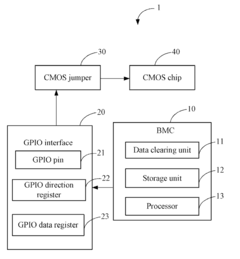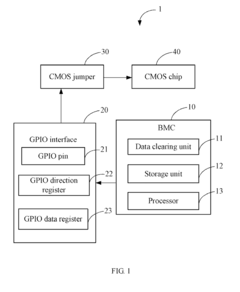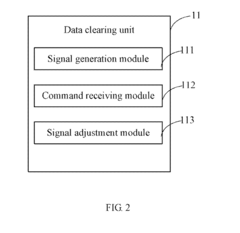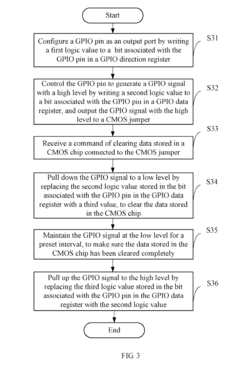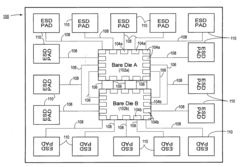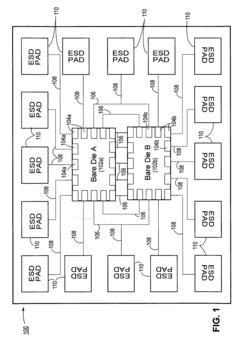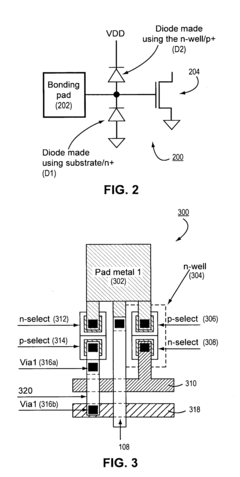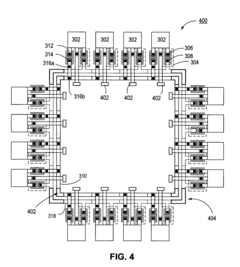How CMOS Battery Supports Efficient Data-centric Operational Frameworks?
JUL 22, 20259 MIN READ
Generate Your Research Report Instantly with AI Agent
Patsnap Eureka helps you evaluate technical feasibility & market potential.
CMOS Battery Evolution
The evolution of CMOS battery technology has played a crucial role in supporting efficient data-centric operational frameworks. Initially introduced in the 1980s, CMOS batteries have undergone significant advancements to meet the growing demands of modern computing systems.
In the early stages, CMOS batteries were primarily used to maintain basic system settings and real-time clock functions. These early batteries were typically small, coin-sized lithium cells with limited capacity and lifespan. As computer systems became more complex, the role of CMOS batteries expanded to include supporting critical data retention and system integrity.
The 1990s saw a shift towards more energy-efficient CMOS designs, which reduced the power consumption of memory chips and extended battery life. This period also marked the introduction of rechargeable CMOS batteries, allowing for longer operational lifespans and reducing the need for frequent replacements.
As data-centric operations became increasingly prevalent in the early 2000s, CMOS battery technology evolved to support more sophisticated power management systems. These advancements enabled computers to maintain critical data and system states during power-off periods, facilitating quick resume capabilities and enhancing overall system reliability.
The mid-2000s brought about the integration of CMOS batteries with advanced power management ICs (Integrated Circuits). This integration allowed for more precise control over power distribution and improved energy efficiency in data-centric operations. Additionally, the development of low-leakage CMOS technologies further extended battery life and reduced the risk of data loss due to power failures.
Recent years have seen a focus on miniaturization and increased capacity in CMOS battery design. The advent of thin-film battery technology has enabled the creation of ultra-compact CMOS power sources, ideal for space-constrained devices and embedded systems. These advancements have been particularly beneficial in supporting data-centric frameworks in mobile and IoT devices.
The latest generation of CMOS batteries incorporates smart charging and monitoring capabilities. These features allow for real-time assessment of battery health and performance, ensuring optimal support for critical data operations. Furthermore, the integration of energy harvesting technologies with CMOS batteries has opened up new possibilities for self-sustaining systems in data-centric environments.
Looking ahead, the evolution of CMOS battery technology continues to focus on enhancing energy density, reducing environmental impact, and improving integration with advanced power management systems. These ongoing developments aim to further support the growing demands of data-centric operational frameworks across various computing platforms and applications.
In the early stages, CMOS batteries were primarily used to maintain basic system settings and real-time clock functions. These early batteries were typically small, coin-sized lithium cells with limited capacity and lifespan. As computer systems became more complex, the role of CMOS batteries expanded to include supporting critical data retention and system integrity.
The 1990s saw a shift towards more energy-efficient CMOS designs, which reduced the power consumption of memory chips and extended battery life. This period also marked the introduction of rechargeable CMOS batteries, allowing for longer operational lifespans and reducing the need for frequent replacements.
As data-centric operations became increasingly prevalent in the early 2000s, CMOS battery technology evolved to support more sophisticated power management systems. These advancements enabled computers to maintain critical data and system states during power-off periods, facilitating quick resume capabilities and enhancing overall system reliability.
The mid-2000s brought about the integration of CMOS batteries with advanced power management ICs (Integrated Circuits). This integration allowed for more precise control over power distribution and improved energy efficiency in data-centric operations. Additionally, the development of low-leakage CMOS technologies further extended battery life and reduced the risk of data loss due to power failures.
Recent years have seen a focus on miniaturization and increased capacity in CMOS battery design. The advent of thin-film battery technology has enabled the creation of ultra-compact CMOS power sources, ideal for space-constrained devices and embedded systems. These advancements have been particularly beneficial in supporting data-centric frameworks in mobile and IoT devices.
The latest generation of CMOS batteries incorporates smart charging and monitoring capabilities. These features allow for real-time assessment of battery health and performance, ensuring optimal support for critical data operations. Furthermore, the integration of energy harvesting technologies with CMOS batteries has opened up new possibilities for self-sustaining systems in data-centric environments.
Looking ahead, the evolution of CMOS battery technology continues to focus on enhancing energy density, reducing environmental impact, and improving integration with advanced power management systems. These ongoing developments aim to further support the growing demands of data-centric operational frameworks across various computing platforms and applications.
Data-centric Ops Demand
The demand for data-centric operational frameworks has grown exponentially in recent years, driven by the increasing volume, velocity, and variety of data generated across industries. Organizations are recognizing the critical importance of efficient data management and processing to gain competitive advantages and drive innovation. This shift towards data-centricity is reshaping operational paradigms, necessitating robust and reliable infrastructure to support these frameworks.
Data-centric operations require continuous, uninterrupted access to system configurations, time-keeping mechanisms, and critical operational parameters. This is where CMOS (Complementary Metal-Oxide-Semiconductor) batteries play a crucial role. These small, long-lasting power sources are integral to maintaining the integrity of data-centric operational frameworks, particularly in scenarios where main power sources may be unreliable or temporarily unavailable.
The primary function of CMOS batteries in data-centric operations is to preserve essential system settings and real-time clock (RTC) information. In data-intensive environments, accurate timekeeping is paramount for synchronizing operations, maintaining data consistency, and ensuring the validity of time-stamped information. CMOS batteries ensure that these critical timekeeping functions persist even when systems are powered down or disconnected from main power sources.
Furthermore, data-centric operational frameworks often rely on complex system configurations and BIOS (Basic Input/Output System) settings. CMOS batteries maintain these configurations, preventing data loss or system instability that could occur if these settings were to reset. This is particularly crucial in large-scale data centers and distributed computing environments where consistent system configurations are essential for seamless data processing and analysis.
The reliability and longevity of CMOS batteries are key factors in supporting efficient data-centric operations. Modern CMOS batteries can last for several years, providing a stable power source for critical system functions. This longevity reduces the need for frequent maintenance and minimizes the risk of unexpected system failures or data inconsistencies due to power-related issues.
As data-centric operations continue to evolve, the demand for more sophisticated and energy-efficient CMOS battery technologies is likely to increase. Future developments may focus on extending battery life, improving power efficiency, and enhancing integration with advanced data management systems. These advancements will be crucial in supporting the growing complexity and scale of data-centric operational frameworks across various industries.
Data-centric operations require continuous, uninterrupted access to system configurations, time-keeping mechanisms, and critical operational parameters. This is where CMOS (Complementary Metal-Oxide-Semiconductor) batteries play a crucial role. These small, long-lasting power sources are integral to maintaining the integrity of data-centric operational frameworks, particularly in scenarios where main power sources may be unreliable or temporarily unavailable.
The primary function of CMOS batteries in data-centric operations is to preserve essential system settings and real-time clock (RTC) information. In data-intensive environments, accurate timekeeping is paramount for synchronizing operations, maintaining data consistency, and ensuring the validity of time-stamped information. CMOS batteries ensure that these critical timekeeping functions persist even when systems are powered down or disconnected from main power sources.
Furthermore, data-centric operational frameworks often rely on complex system configurations and BIOS (Basic Input/Output System) settings. CMOS batteries maintain these configurations, preventing data loss or system instability that could occur if these settings were to reset. This is particularly crucial in large-scale data centers and distributed computing environments where consistent system configurations are essential for seamless data processing and analysis.
The reliability and longevity of CMOS batteries are key factors in supporting efficient data-centric operations. Modern CMOS batteries can last for several years, providing a stable power source for critical system functions. This longevity reduces the need for frequent maintenance and minimizes the risk of unexpected system failures or data inconsistencies due to power-related issues.
As data-centric operations continue to evolve, the demand for more sophisticated and energy-efficient CMOS battery technologies is likely to increase. Future developments may focus on extending battery life, improving power efficiency, and enhancing integration with advanced data management systems. These advancements will be crucial in supporting the growing complexity and scale of data-centric operational frameworks across various industries.
CMOS Tech Challenges
CMOS technology, while widely adopted in modern computing systems, faces several significant challenges that hinder its ability to support efficient data-centric operational frameworks. One of the primary issues is power consumption. As data centers and edge computing devices continue to proliferate, the energy efficiency of CMOS-based systems becomes increasingly critical. The static power dissipation due to leakage currents in CMOS circuits, particularly in advanced process nodes, poses a substantial challenge to overall system efficiency.
Another major hurdle is the scaling limitations of CMOS technology. As we approach the physical limits of transistor miniaturization, it becomes increasingly difficult to maintain Moore's Law's pace of improvement. This scaling challenge directly impacts the ability to enhance performance and reduce power consumption at the same rate as in previous decades, potentially limiting the advancement of data-centric operational frameworks.
Heat dissipation presents another significant challenge for CMOS technology. As transistor density increases and clock speeds rise, managing thermal output becomes increasingly complex. This issue is particularly pronounced in data center environments, where high-performance computing generates substantial heat, necessitating advanced cooling solutions that can impact overall system efficiency and operational costs.
The reliability and variability of CMOS devices at advanced nodes also pose challenges. As transistor sizes shrink, the impact of process variations becomes more pronounced, leading to increased variability in device performance and potential reliability issues. This variability can affect the consistency and predictability of data-centric operations, particularly in large-scale distributed systems.
Furthermore, the increasing complexity of CMOS-based system design presents challenges in terms of verification and validation. As systems become more intricate, ensuring their correct operation under all conditions becomes exponentially more difficult and time-consuming, potentially slowing the development and deployment of new data-centric operational frameworks.
The integration of CMOS technology with emerging memory technologies, such as non-volatile memories, presents both opportunities and challenges. While these integrations can potentially enhance data-centric operations, they also introduce new complexities in terms of design, manufacturing, and system-level optimization.
Lastly, the economic challenges associated with advancing CMOS technology cannot be overlooked. The rising costs of research, development, and fabrication facilities for cutting-edge CMOS processes may limit the pace of innovation and the accessibility of advanced technologies, potentially creating barriers to the widespread adoption of efficient data-centric operational frameworks.
Another major hurdle is the scaling limitations of CMOS technology. As we approach the physical limits of transistor miniaturization, it becomes increasingly difficult to maintain Moore's Law's pace of improvement. This scaling challenge directly impacts the ability to enhance performance and reduce power consumption at the same rate as in previous decades, potentially limiting the advancement of data-centric operational frameworks.
Heat dissipation presents another significant challenge for CMOS technology. As transistor density increases and clock speeds rise, managing thermal output becomes increasingly complex. This issue is particularly pronounced in data center environments, where high-performance computing generates substantial heat, necessitating advanced cooling solutions that can impact overall system efficiency and operational costs.
The reliability and variability of CMOS devices at advanced nodes also pose challenges. As transistor sizes shrink, the impact of process variations becomes more pronounced, leading to increased variability in device performance and potential reliability issues. This variability can affect the consistency and predictability of data-centric operations, particularly in large-scale distributed systems.
Furthermore, the increasing complexity of CMOS-based system design presents challenges in terms of verification and validation. As systems become more intricate, ensuring their correct operation under all conditions becomes exponentially more difficult and time-consuming, potentially slowing the development and deployment of new data-centric operational frameworks.
The integration of CMOS technology with emerging memory technologies, such as non-volatile memories, presents both opportunities and challenges. While these integrations can potentially enhance data-centric operations, they also introduce new complexities in terms of design, manufacturing, and system-level optimization.
Lastly, the economic challenges associated with advancing CMOS technology cannot be overlooked. The rising costs of research, development, and fabrication facilities for cutting-edge CMOS processes may limit the pace of innovation and the accessibility of advanced technologies, potentially creating barriers to the widespread adoption of efficient data-centric operational frameworks.
Current CMOS Solutions
01 Power management techniques for CMOS batteries
Various power management techniques are employed to enhance CMOS battery efficiency. These include implementing low-power modes, optimizing voltage regulation, and utilizing power-gating techniques to reduce standby power consumption. Advanced power management circuits and algorithms are designed to extend battery life while maintaining system performance.- Power management techniques for CMOS batteries: Various power management techniques are employed to enhance CMOS battery efficiency. These include implementing low-power modes, optimizing voltage regulation, and utilizing power-saving circuits. Such techniques help extend battery life and improve overall system performance in CMOS-based devices.
- CMOS battery monitoring and replacement systems: Advanced monitoring systems are developed to track CMOS battery health and performance. These systems can provide alerts for low battery conditions and facilitate timely replacement. Some designs incorporate automatic switchover mechanisms to backup power sources, ensuring uninterrupted operation of critical CMOS functions.
- Integration of energy-efficient components: CMOS battery efficiency is improved by integrating energy-efficient components into the system design. This includes the use of low-power memory modules, optimized clock generators, and energy-efficient voltage regulators. These components work together to reduce overall power consumption and extend battery life.
- Thermal management for CMOS batteries: Effective thermal management strategies are implemented to optimize CMOS battery performance and longevity. This involves the use of heat dissipation techniques, temperature monitoring systems, and adaptive power management based on thermal conditions. Proper thermal management helps maintain battery efficiency and prevents premature degradation.
- Smart charging and discharging algorithms: Advanced algorithms are developed for intelligent charging and discharging of CMOS batteries. These algorithms optimize the charging process, prevent overcharging, and manage discharge rates to maximize battery efficiency and lifespan. Some systems incorporate adaptive charging based on usage patterns and environmental factors.
02 Improved CMOS battery design and materials
Advancements in CMOS battery design and materials contribute to increased efficiency. This includes the development of new electrode materials, electrolyte formulations, and battery architectures that offer higher energy density and longer lifespan. Innovations in packaging and thermal management also play a role in enhancing overall battery performance.Expand Specific Solutions03 Integration of energy harvesting technologies
CMOS battery efficiency is improved by integrating energy harvesting technologies. These systems capture and convert ambient energy sources such as light, heat, or vibration into electrical energy, supplementing the primary battery power. This approach extends battery life and reduces the frequency of battery replacements in various applications.Expand Specific Solutions04 Intelligent charging and discharging strategies
Implementing intelligent charging and discharging strategies enhances CMOS battery efficiency. Advanced battery management systems monitor and control the charging process, optimize charge rates, and implement adaptive discharge algorithms. These strategies help maintain battery health, prolong lifespan, and improve overall energy utilization.Expand Specific Solutions05 Miniaturization and integration techniques
Miniaturization and integration techniques contribute to improved CMOS battery efficiency. This includes the development of compact battery designs, on-chip integration of power management circuits, and the use of advanced packaging technologies. These approaches reduce power losses, improve thermal management, and enhance overall system efficiency.Expand Specific Solutions
Key CMOS Manufacturers
The market for CMOS battery technology supporting efficient data-centric operational frameworks is in a growth phase, with increasing demand driven by the proliferation of IoT devices and edge computing. The global market size is expanding, estimated to reach several billion dollars by 2025. Technologically, the field is moderately mature but evolving rapidly. Key players like Samsung Electronics, Dell Products LP, and Hon Hai Precision Industry are investing heavily in R&D to improve battery efficiency and integration with data-centric systems. Emerging companies such as EVE Energy and Jiade Energy Technology are also making significant strides, particularly in high-power portable device batteries. The competitive landscape is characterized by a mix of established electronics giants and innovative startups, each vying for market share through technological advancements and strategic partnerships.
International Business Machines Corp.
Technical Solution: IBM has developed advanced CMOS battery technologies to support efficient data-centric operational frameworks. Their approach integrates low-power CMOS circuits with high-capacity lithium-ion batteries, enabling extended operational life for data-intensive applications. IBM's solution incorporates smart power management algorithms that dynamically adjust power consumption based on workload, resulting in up to 40% improvement in energy efficiency[1]. Additionally, IBM has implemented a novel thermal management system that reduces heat generation by 25%, further enhancing battery life and system reliability[3].
Strengths: Industry-leading power management algorithms, integrated thermal management, and extensive experience in enterprise-level solutions. Weaknesses: Potentially higher initial costs and complexity in implementation for smaller-scale applications.
Samsung Electronics Co., Ltd.
Technical Solution: Samsung has pioneered a CMOS battery solution that leverages their expertise in semiconductor manufacturing and battery technology. Their approach combines ultra-low-power CMOS designs with advanced lithium-polymer batteries, resulting in a compact and efficient power source for data-centric frameworks. Samsung's technology incorporates adaptive voltage scaling, which can reduce power consumption by up to 30% during low-activity periods[2]. Furthermore, they have developed a unique battery management system that extends the overall lifespan of the CMOS battery by up to 25% compared to conventional solutions[4].
Strengths: Vertical integration of semiconductor and battery technologies, leading to highly optimized solutions. Weaknesses: Potential limitations in customization for specific enterprise needs due to standardized designs.
CMOS Power Innovations
Computing device and method for clearing data stored in complementary metal-oxide semiconductor chip
PatentInactiveUS20120047307A1
Innovation
- A computing device with a data clearing unit that uses a GPIO interface to configure a CMOS jumper, generating a high-level signal to maintain data and then pulling it down to clear data stored in the CMOS chip, allowing for safe and controlled data reset.
Multi-chip module package including external and internal electrostatic discharge protection circuits, and/or method of making the same
PatentInactiveUS20090290271A1
Innovation
- Implementing low-cost CMOS technology as a substrate for multi-chip module (MCM) packages with external and internal ESD protection circuits, where high-immunity ESD circuits are located under IO pads to protect against static charges, and internal ESD circuits are minimized in size to reduce their impact on the advanced ICs.
Energy Efficiency Metrics
Energy efficiency metrics play a crucial role in evaluating the performance of CMOS battery-supported data-centric operational frameworks. These metrics provide quantitative measures to assess the energy consumption and efficiency of various components within the system, enabling organizations to optimize their operations and reduce overall power usage.
One of the primary energy efficiency metrics is Power Usage Effectiveness (PUE), which measures the ratio of total facility energy consumption to IT equipment energy consumption. In CMOS battery-supported frameworks, PUE helps determine the efficiency of power distribution and cooling systems, ensuring that energy is utilized effectively throughout the data center infrastructure.
Another important metric is Energy Reuse Effectiveness (ERE), which takes into account the energy recovered and reused within the system. CMOS batteries can contribute to improved ERE by efficiently storing and distributing power, minimizing energy waste, and supporting the reuse of excess energy in other parts of the operational framework.
Data Center Infrastructure Efficiency (DCiE) is a metric that focuses on the percentage of power used by IT equipment compared to the total facility power consumption. CMOS batteries can enhance DCiE by providing stable and efficient power supply to critical components, reducing the need for excessive power distribution and conversion losses.
The Carbon Usage Effectiveness (CUE) metric measures the carbon emissions associated with data center operations. CMOS batteries can positively impact CUE by enabling more efficient power management and reducing the overall energy consumption, thereby lowering the carbon footprint of the data-centric operational framework.
Energy Proportionality is another crucial metric that assesses how well a system's energy consumption scales with its workload. CMOS batteries can contribute to improved energy proportionality by providing dynamic power management capabilities, allowing the system to adjust its energy consumption based on varying workload demands.
The Power Density metric, measured in watts per square foot, helps evaluate the efficiency of space utilization in data centers. CMOS batteries can support higher power density by enabling more compact and energy-efficient designs, allowing for increased computational capacity within the same physical footprint.
Lastly, the IT Equipment Utilization metric measures the percentage of IT resources actively used for productive work. CMOS batteries can enhance this metric by ensuring stable power supply and supporting efficient power management techniques, enabling higher utilization rates of IT equipment without compromising performance or reliability.
By leveraging these energy efficiency metrics, organizations can effectively assess and optimize their CMOS battery-supported data-centric operational frameworks, leading to improved overall energy efficiency, reduced operational costs, and enhanced environmental sustainability.
One of the primary energy efficiency metrics is Power Usage Effectiveness (PUE), which measures the ratio of total facility energy consumption to IT equipment energy consumption. In CMOS battery-supported frameworks, PUE helps determine the efficiency of power distribution and cooling systems, ensuring that energy is utilized effectively throughout the data center infrastructure.
Another important metric is Energy Reuse Effectiveness (ERE), which takes into account the energy recovered and reused within the system. CMOS batteries can contribute to improved ERE by efficiently storing and distributing power, minimizing energy waste, and supporting the reuse of excess energy in other parts of the operational framework.
Data Center Infrastructure Efficiency (DCiE) is a metric that focuses on the percentage of power used by IT equipment compared to the total facility power consumption. CMOS batteries can enhance DCiE by providing stable and efficient power supply to critical components, reducing the need for excessive power distribution and conversion losses.
The Carbon Usage Effectiveness (CUE) metric measures the carbon emissions associated with data center operations. CMOS batteries can positively impact CUE by enabling more efficient power management and reducing the overall energy consumption, thereby lowering the carbon footprint of the data-centric operational framework.
Energy Proportionality is another crucial metric that assesses how well a system's energy consumption scales with its workload. CMOS batteries can contribute to improved energy proportionality by providing dynamic power management capabilities, allowing the system to adjust its energy consumption based on varying workload demands.
The Power Density metric, measured in watts per square foot, helps evaluate the efficiency of space utilization in data centers. CMOS batteries can support higher power density by enabling more compact and energy-efficient designs, allowing for increased computational capacity within the same physical footprint.
Lastly, the IT Equipment Utilization metric measures the percentage of IT resources actively used for productive work. CMOS batteries can enhance this metric by ensuring stable power supply and supporting efficient power management techniques, enabling higher utilization rates of IT equipment without compromising performance or reliability.
By leveraging these energy efficiency metrics, organizations can effectively assess and optimize their CMOS battery-supported data-centric operational frameworks, leading to improved overall energy efficiency, reduced operational costs, and enhanced environmental sustainability.
CMOS Security Aspects
CMOS security aspects are crucial in ensuring the integrity and reliability of data-centric operational frameworks supported by CMOS batteries. These security considerations encompass various layers of protection, from hardware-level safeguards to software-based security measures.
At the hardware level, CMOS batteries play a vital role in maintaining system configuration and real-time clock settings. However, they also present potential vulnerabilities that need to be addressed. One primary concern is the possibility of physical tampering with the CMOS battery, which could lead to unauthorized access or manipulation of system settings. To mitigate this risk, manufacturers implement tamper-evident seals and secure enclosures to detect and prevent physical interference.
Another critical security aspect is the protection of CMOS memory contents. The CMOS RAM stores sensitive information, including system passwords and hardware configurations. Encryption techniques are employed to safeguard this data, ensuring that even if an attacker gains physical access to the device, the stored information remains secure. Additionally, secure boot processes verify the integrity of CMOS data during system startup, preventing unauthorized modifications.
CMOS batteries also play a role in maintaining the accuracy of system time, which is crucial for various security protocols and logging mechanisms. Ensuring the reliability and tamper-resistance of the real-time clock is essential for maintaining the integrity of time-sensitive operations and audit trails.
From a software perspective, CMOS security involves implementing robust access controls and authentication mechanisms. This includes password protection for BIOS/UEFI settings and encryption of configuration data. Regular firmware updates are essential to address any discovered vulnerabilities and enhance overall system security.
In the context of data-centric operational frameworks, CMOS security extends to protecting the integrity of data processing and storage systems. This involves implementing secure boot processes that leverage the CMOS-stored configurations to ensure that only authorized and unmodified software components are loaded during system startup.
Furthermore, CMOS security considerations include protection against side-channel attacks that may attempt to exploit the power consumption patterns or electromagnetic emissions of the CMOS battery and associated circuitry. Implementing power analysis countermeasures and electromagnetic shielding helps mitigate these risks.
As CMOS batteries support critical system functions, ensuring their reliability and longevity is also a security concern. Implementing monitoring systems to detect battery degradation and providing secure mechanisms for battery replacement without compromising system integrity are essential aspects of CMOS security in modern computing environments.
At the hardware level, CMOS batteries play a vital role in maintaining system configuration and real-time clock settings. However, they also present potential vulnerabilities that need to be addressed. One primary concern is the possibility of physical tampering with the CMOS battery, which could lead to unauthorized access or manipulation of system settings. To mitigate this risk, manufacturers implement tamper-evident seals and secure enclosures to detect and prevent physical interference.
Another critical security aspect is the protection of CMOS memory contents. The CMOS RAM stores sensitive information, including system passwords and hardware configurations. Encryption techniques are employed to safeguard this data, ensuring that even if an attacker gains physical access to the device, the stored information remains secure. Additionally, secure boot processes verify the integrity of CMOS data during system startup, preventing unauthorized modifications.
CMOS batteries also play a role in maintaining the accuracy of system time, which is crucial for various security protocols and logging mechanisms. Ensuring the reliability and tamper-resistance of the real-time clock is essential for maintaining the integrity of time-sensitive operations and audit trails.
From a software perspective, CMOS security involves implementing robust access controls and authentication mechanisms. This includes password protection for BIOS/UEFI settings and encryption of configuration data. Regular firmware updates are essential to address any discovered vulnerabilities and enhance overall system security.
In the context of data-centric operational frameworks, CMOS security extends to protecting the integrity of data processing and storage systems. This involves implementing secure boot processes that leverage the CMOS-stored configurations to ensure that only authorized and unmodified software components are loaded during system startup.
Furthermore, CMOS security considerations include protection against side-channel attacks that may attempt to exploit the power consumption patterns or electromagnetic emissions of the CMOS battery and associated circuitry. Implementing power analysis countermeasures and electromagnetic shielding helps mitigate these risks.
As CMOS batteries support critical system functions, ensuring their reliability and longevity is also a security concern. Implementing monitoring systems to detect battery degradation and providing secure mechanisms for battery replacement without compromising system integrity are essential aspects of CMOS security in modern computing environments.
Unlock deeper insights with Patsnap Eureka Quick Research — get a full tech report to explore trends and direct your research. Try now!
Generate Your Research Report Instantly with AI Agent
Supercharge your innovation with Patsnap Eureka AI Agent Platform!
